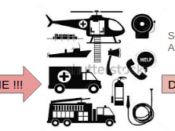The Research Team met at Microsoft Research India, in Bangalore, to formulate a practical and appropriate research design to test the hypothesis – “pictographs, designed for the linguistically challenged, can effectively communicate disaster information for saving lives and livelihoods.”
 In the context of disaster communication we have identified two key communication requirements, illustrated in the image above. First is a person or people in distress asking for help from the Emergency Response Services, during a large crisis. Second is the Alerting Authorities sharing warnings of eminent threats to a targeted wide audience.
In the context of disaster communication we have identified two key communication requirements, illustrated in the image above. First is a person or people in distress asking for help from the Emergency Response Services, during a large crisis. Second is the Alerting Authorities sharing warnings of eminent threats to a targeted wide audience.
To that end, there were three key issues the team addressed and worked on during the meeting:
- Why use pictographs over text, voice, or video, during a crisis?
- How do we define “linguistically challenged” in the context of disaster communication?
- What is an appropriate research design to gather evidence for a scientific publication?
Why “pictographs” over other modes?
 During a crisis, often telecommunication networks are congested and emergency service hotlines become overwhelmed, making it difficult to connect a voice call. However, a SMS text, with a store-and-forward, would reach the emergency services, at some point. Evidence points to the use of text-ing and the adoption of Internet, over voice telephony, is relatively low in Asia Pacific.
During a crisis, often telecommunication networks are congested and emergency service hotlines become overwhelmed, making it difficult to connect a voice call. However, a SMS text, with a store-and-forward, would reach the emergency services, at some point. Evidence points to the use of text-ing and the adoption of Internet, over voice telephony, is relatively low in Asia Pacific.
Most countries, on average, are home to 3-5 languages. To issue an alert message in all languages is challenging; especially, considering tourists and migrant workers who may not know any of the local languages. TV and Radio are not always on and operational to make use of a voice or video message, in the local language, during a sudden or slow onset hazard event. Such events give a very short warning window; typically, less than 30 minutes. Mobile phones present themselves as a lucrative technology in this situation.
What is “linguistically challenged”?
 In the disaster communication, linguistically challenge (or functionally illiterate) extends beyond simply being illiterate or low-literate. An elderly person, accustomed simple telephone calls, might struggle with deciphering a text message; especially, if it carries a lengthy message explaining a distress and response instruction with complicated language. There are others with cognitive challenges such as people with Autism who have similar difficulties. Realizing these challenges that marginalize populations with disaster communication we believe that pictographs could be a solution in bridging these communication gaps.
In the disaster communication, linguistically challenge (or functionally illiterate) extends beyond simply being illiterate or low-literate. An elderly person, accustomed simple telephone calls, might struggle with deciphering a text message; especially, if it carries a lengthy message explaining a distress and response instruction with complicated language. There are others with cognitive challenges such as people with Autism who have similar difficulties. Realizing these challenges that marginalize populations with disaster communication we believe that pictographs could be a solution in bridging these communication gaps.
Towards a Research Design
Research team needs to be enthused with an achievable goal and incentive to engage in this research. Therefore, it was agreed that a key output should be a scientific publication. For such it was important that we carry out a scientifically valid research. MSRI proposed that we seek assistance from the Industrial Design Center of the Indian Institute of Technology Bombay. They would develop a methodology to carryout a user-centered probing study on a proportionate sample of people in Bombay.
The study taking into consideration the urban and rural divide. The domain scope would be limited to hydrological and meteorological hazard events such as floods, storms, landslides, etc. It was realized from the short duration of the project that it would be impossible to show any impact during this innovation realization stage. Impact studies are quite costly. However, it is important to be mindful of “what kind of impact we expect and which impact we can show?” We may also want to be mindful of the cross-cultural and gender issues that may related to the study.
The “Mobile Pictographs for Disaster Communication” project is supported by Elrha’s Humanitarian Innovation Fund.


Leave a Reply